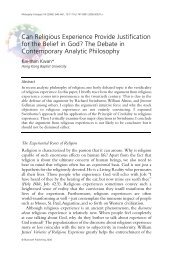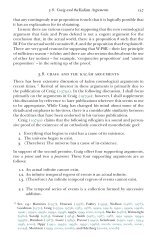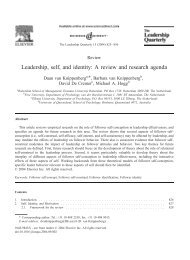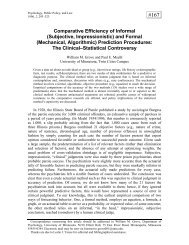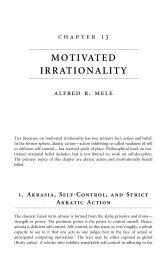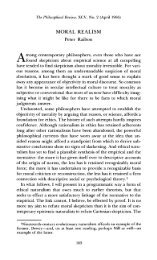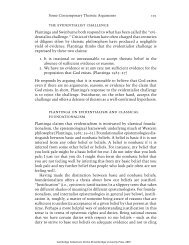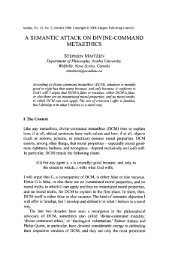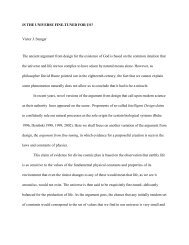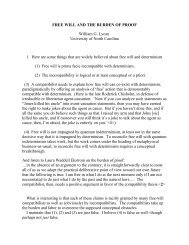Atheism and Theism JJ Haldane - Common Sense Atheism
Atheism and Theism JJ Haldane - Common Sense Atheism
Atheism and Theism JJ Haldane - Common Sense Atheism
You also want an ePaper? Increase the reach of your titles
YUMPU automatically turns print PDFs into web optimized ePapers that Google loves.
Further Reflections on <strong>Theism</strong> 225<br />
components of cells are proteins <strong>and</strong> nucleic acids. The latter (DNA <strong>and</strong><br />
RNA) carry the information that give rise to the former; while the former<br />
are both the builders of cellular structures <strong>and</strong> catalysts of various reactions<br />
including the replication of DNA (<strong>and</strong> the encoding of the information it<br />
carries into ‘messenger’ RNA). Evidently an account of the origination of<br />
cellular life needs to involve both proteins <strong>and</strong> nucleic acids, <strong>and</strong> to say how<br />
each gave rise to the other; but given the characterization of their roles it<br />
is unclear how an such account can escape circularity. The formation <strong>and</strong><br />
replication of nucleic acids depend upon the catalytic role of proteins; <strong>and</strong> production<br />
of proteins depends upon the information encoded in the nucleic<br />
acids. One answer may be to trace these distinct functions back to some<br />
common molecular ‘nucleo-protein source’ in which both roles featured. As<br />
a form of words that sounds as if it may be a solution, but logically it has the<br />
form of saying that the chicken <strong>and</strong> egg problem can be solved by postulating<br />
a prior entity that was at one <strong>and</strong> the same time a chicken <strong>and</strong> an egg (or at<br />
least chickenish <strong>and</strong> eggish): a ‘chickeno-egg source’. In fact, as a solution to<br />
the origin of life (as contrasted with that of ‘proto-life’) it does not begin<br />
to bridge the gap between the existence of a ‘semi-replicating’ nucleo-protein<br />
<strong>and</strong> a reactive, metabolizing, growing self-replicating, organism. This last<br />
problem also besets the theory that life did not originate with proteins<br />
or nucleic acids but with crystals suspended in the primitive clay. 3 On this<br />
account the properties of life can be traced to the growth <strong>and</strong> propagation of<br />
crystalline structures which, by stages, incorporated ‘proto-proteins’ from the<br />
surrounding material. The difficulty is that while crystals propagate, they do<br />
not replicate in the sense required for evolution; that is they do not encode<br />
new information or mutate into new kinds; <strong>and</strong> nor do they interact with<br />
their environment or exhibit any kind of metabolism. In short, they are not<br />
living organisms even of the most primitive kind. 4<br />
Quite apart from the complexity of the science involved in trying to<br />
model the material conditions under which life began, the problem is in<br />
the first instance one of conceptual coherence. This is why, if my doubts<br />
are correct, problems of emergence are not equivalent to claims of the contingent<br />
absence of a naturalistic developmental account. Similar difficulties<br />
recur with further stages in the story of natural evolution. In the same<br />
year that <strong>Atheism</strong> <strong>and</strong> <strong>Theism</strong> first appeared (1996) Michael Behe published<br />
Darwin’s Black Box in which he argues that the existence of ‘irreducible complexity’<br />
in biology is an impediment to naturalistic evolutionary explanations. 5<br />
As Behe notes, Darwin himself had no conception of the biochemistry<br />
underlying biological change <strong>and</strong> the transmission of genetic information.<br />
His theory simply postulated r<strong>and</strong>om mutation leading through natural selection<br />
to differential survival <strong>and</strong> fecundity. The main areas of subsequent<br />
research, however, have been those of genetics <strong>and</strong> molecular biology, <strong>and</strong>



